INTRODUCTION
In 1960, the Thai dairy industry has been developed after the King of Denmark gave some dairy cows to the King of Thailand during his visit to Denmark. The King has started the Dairy Farming Promotion Organization of Thailand and Livestock Department started AI. Holstein Friesian breed to native cows in 1971. Since 1983, Thailand has imported 50,000 dairy cows from Australia and New Zealand.
Nowadays, Thailand has a raw milk production capacity of 2,800 tons a day, or just over one million tons per year (2015). Forty percent of production goes to a school milk program and the rest to the commercial dairy sector (Thongnoi, 2015). Giving to the Ministry of Agricultural and Cooperatives, Thailand is the largest producer and exporter of dairy products in the ASEAN.
In recent year, Thailand has increased demand for meat, milk and milk products. Despite great increases in local milk production, the accelerating demand for dairy products still exceeds the available local supply.
DAIRY PRODUCTION AND TRADE IN THAILAND
Dairy production in Thailand
Previously, milk was never an important product in Thailand, and later until the second half of the 20th century. But during the past 15 years, Thailand milk animals increase more than 1,5 times (Fig. 1).
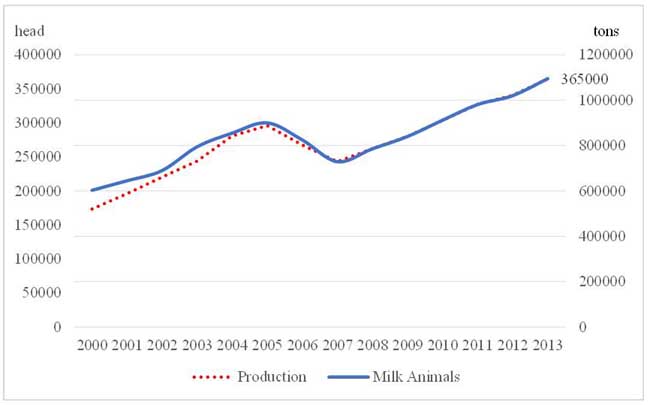
Fig. 1. Milk animals and the production in Thailand from 2000-2013
Source: FAOSTAT (2016)
In Fig. 1 shows the quantity of milk animals and production in Thailand. Recently, we can see a plateau trend. Perhaps, dairy production in Thailand has reached the limit of productivity.
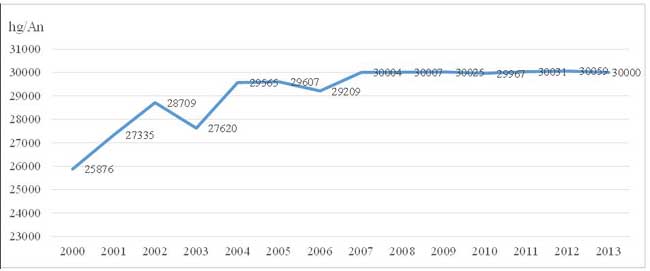
Fig. 2. The yield of dairy animals in Thailand from 2000-2013
Source: FAOSTAT (2016)
The graph shows the yield of dairy animals in Thailand by hectogram per animal. We can see the trend is limited in terms of yield. It is about 3000 hectograms per animal in the recnet 7 years (Fig.2). During those times, the yield of Thai dairy animals increased nearly 1.2 times. The yield of Thailand is the same with some Asean countries.
According to the report of the dairy sector in Thailand, we can see the source of raw milk from 2 main agents. Raw milk from the cooperatives and milk collection center. These sturdy little cooperatives, formed by small dairy farmers who own an average of 15 to 20 lactating cows, supply the daily milk requirements of the government school milk feeding program as well as the raw milk requirements of the manufacturers of milk products.
Milk cooperatives in Thailand are formed through long-term startup loans granted to farmers. The milk cooperatives, in turn, form the cooperative managed by the Dairy Farming Promotion Organization (DPO), a state controlled enterprise mandated to promote the growth of the industry.
The milk cooperatives adjust in size and processing activities, but primarily serve as milk collection facilities. Some cooperatives only treat milk for direct consumption, while some also engage in the processing of milk products such as flavored milk, and produce yogurt and cheese. Thailand now has more than 97 milk cooperatives, the largest of which is the Nongpho Ratchaburi Dairy Cooperative located in Ratchaburi province.
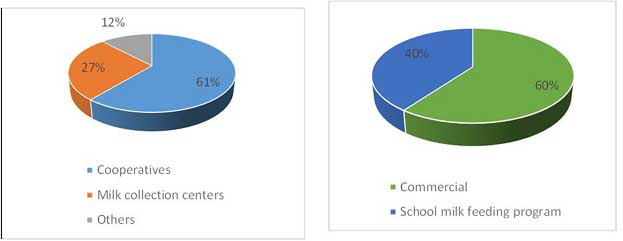
Fig. 3. The source of raw milk and market share in Thailand in 2013
In 2013, School Milk is a vital part of the Thai dairy market, so much so that it accounts for about 40% of the total liquid milk market. As a result, school milk days has been expanded from the 200 days school calendar to 230 feeding days, with an extra 30 days of milk for consumption during the holidays. The economic benefits and the support of the national development is less known. Without school milk to provide a stable platform by which to support the growth of the Thai dairy industry, the Thai dairy will definitely not have experienced such growth. Commercial dairy production accounts for about 60% of the market, with 39% of Thai drink liquid milk production daily. As such, many Thai consumers have become increasingly comfortable consuming milk, a significant shift from the traditional perception that milk is only for children. The health and wellness awareness also plays a big part in changing this perception, as more consumers understand that milk is beneficial for the average adult.
The average per capita dairy consumption (including fluid milk, butter, cheese, NFD, and WMP) in milk equivalent in the last decade for the major dairy markets was 10.2 kg in China, 71.8 kg in India, 7.8 kg in Indonesia, 97.6 kg in Japan, 67.8 kg in Malaysia, 24 kg in the Philippines, 80 kg in South Korea, 28.7 in Thailand, and 8.6 kg in Vietnam. This contrasts with per capita consumption of 330 kg in the EU-15, 310 kg per capita in Australia, and 251 kg per capita in the United States.
Thai dairy products trade
The quantity and value of dairy products in Thailand have an increasing trend. Major dairy products producers such as Australia, New Zealand, South Korea and China would easily access the Thai market. Total value of dairy products import in 2015 level US$583 million. In dairy products, value of milk and cream, concentrated or containing added sugar or other sweetening matter (HS Code 0402) always have the highest rate in whole (58% in 2015) (Fig.1).
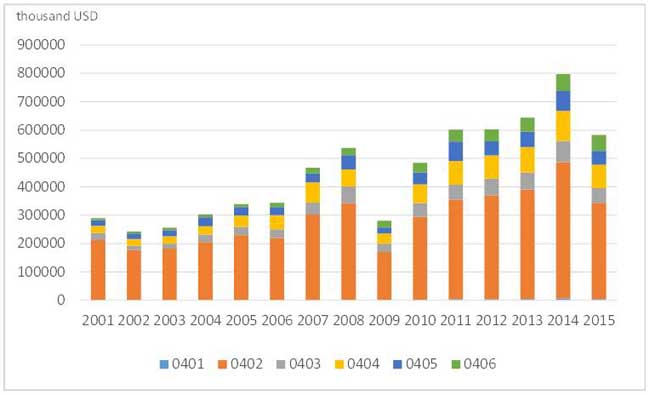
Fig. 4. Dairy products imported in Thailand 2001-2015
Source: TRADEMAP.ORG (2016)
0401 Milk and cream, not concentrated nor containing added sugar or other sweetening matter
0402 Milk and cream, concentrated or containing added sugar or other sweetening matter
0403 Buttermilk, curdled milk and cream, yogurt, kefir and other fermented or acidified milk
0404 Whey, whether or not concentrated or containing added sugar or other sweetening matter; products ..
0405 Butter, incl. dehydrated butter and ghee, and other fats and oils derived from milk; dairy .
0406 Cheese and curd
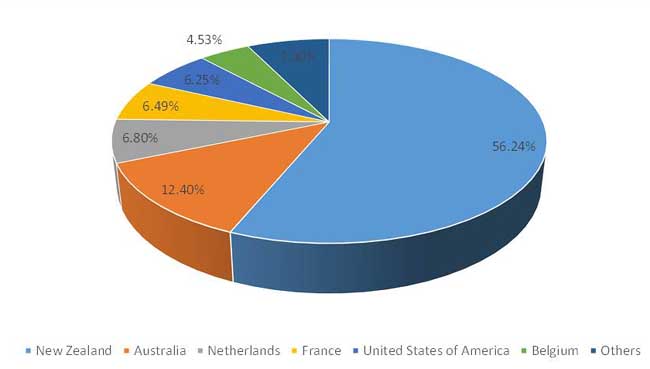
Fig. 5. Share of dairy products imported in Thailand 2015*
Source: TRADEMAP.ORG (2016) * HS Code 0402
Some news five years before it was identified that Thai dairy imports face the risk of losing competitiveness to China and Vietnam after the full implementation of the Asean Economic Community, saying that the industry has a lower efficiency and higher production costs. The free trade agreement and AEC Thai milk producers run the risk of being overthrown, because they will not be able to compete. In fact, dairy products of China or Vietnam which are more dominant than the Thai still cannot compete.
Import value in 2015 of milk and cream, concentrated or containing added sugar or other sweetening matter (HS Code 0402) is US$339 million inside 56.24% from New Zealand, 12.40% from Australia… (Fig. 5)
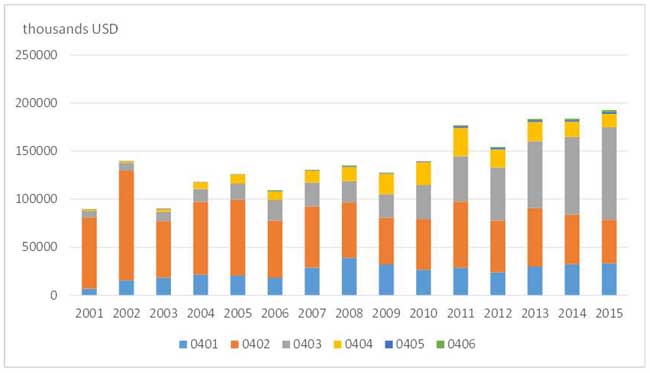
Fig. 6. Dairy products exported by Thailand 2001-2015
Source: TRADEMAP.ORG (2016)
The dairy sector of Thailand now exports milk products to Cambodia, Laos, Myanmar and other neighboring countries. Total of value in dairy products export in 2015 achieved US$192 million (Fig. 6). Cambodia (33.92%) led the dairy export industry in 2014.
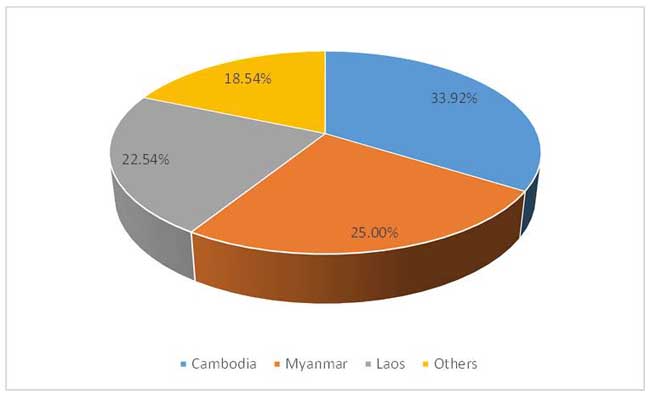
Fig. 7. The markets of exported Dairy products by Thailand 2014*
Source: TRADEMAP.ORG (2016) * HS Code 0402
Balance in value of dairy products in table 1, shows that raw milk is currently in short supply so Thailand has to import milk and milk products with a tax system used to protect their own domestic dairy industry. However, in practice, a tax rate for imported powdered milk is just 5% with the condition that importers must first purchase local products before turning to imported products. Quantity of dairy products in Thailand in the future will be increased and Thailand producers need to emphasize cost reduction and quality improvement for competitive power to survive in the dairy business.
Table 1. Balance in value of dairy products in Thailand from 2011 to 2015
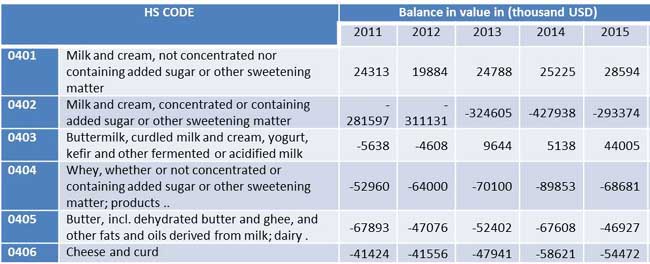
Source: TRADEMAP.ORG (2016)
In 2011 to 2014, the trend of the balance in value in Thailand HS 0401 to 0406 increased but in 2015 the value started falling. The biggest net export is HS CODE 0402 (US$-293 million) in 2015, they are the items that are required to enter Thailand because of insufficient supply. (Fig. 8 and Table 1). It is the main HS CODE effect to the value of dairy trade in Thailand.

Fig. 8. Dairy production balance of trade in Thailand 2015
Source: TRADEMAP.ORG (2016)
CONCLUSION
More than 50 years ago, it was believed that dairy production was not possible in Thailand with its tropical climate and traditional use of cattle as draft animals and sources of meat. Thailand has a relatively short history of dairy farming, having only started in the “60s after a royal visit of King Bhumibol Adulyadej and Queen Sirikit to Denmark in 1960 Concerned government agencies and private enterprises help develop dairy farming and reduce the cost of production.
To provide a long-term market for Thai dairy farmers, the DPO initiated the school milk feeding program among children under 12 years old. The program introduces milk to the diet of Thai children and develops in them a lifelong milk-consumption habit. Nowadays, 40% of quantity of liquid milk are produced in Thailand for this program. These campaigns promote the functional and health benefits, targeting all types of consumers in order to change the perception of Thais that drinking milk is only for growing children.
Milk and cream, concentrated or containing added sugar or other sweetening matter, which is used in condensed milk and snack items, is also produced by small cooperatives but Thailand continues to import the balance of demand. The country still imports around 50,000 tons of powder milk annually. Thailand presently exports milk products to Cambodia, Laos, Malaysia, Myanmar and other neighboring countries.
REFERENCES
Thongnoi, Jitsiree (2015-10-18). "Milking the system". Bangkok Post. Retrieved 18 October 2015.
Chaiyan Lohaphanwong, President of Thai Dairy Industry Association, Big companies , Small farmers : Are there grounds for sustainable marriage ? 2013
Petchanet Pratruangkrai, Experts warn AEC could damage Thai dairy industry. http://www.nationmultimedia.com/news/business/EconomyAndTourism/30184752
School Milk Programme in Thailand By Dr. Issara Suwanabol.
http://www.fao.org/fileadmin/templates/est/COMM_MARKETS_MONITORING/Dairy/Documents/School_Milk_Programme_in_Thailand.pdf
The power of cooperatives in the Thai dairy industry. Czeriza Valencia (The Philippine Star) | Updated July 7, 2013 - 12:00am
Dairy management, health and production in Thailand. Dr Suneerat Aiumlamai, Faculty of Veterinary Medicine, Khon Kaen University, Khon Kaen, Thailand.
|
Date submitted: Dec. 26, 2016
Reviewed, edited and uploaded: Jan. 3, 2017
|


Dairy Production and Trade in Thailand
INTRODUCTION
In 1960, the Thai dairy industry has been developed after the King of Denmark gave some dairy cows to the King of Thailand during his visit to Denmark. The King has started the Dairy Farming Promotion Organization of Thailand and Livestock Department started AI. Holstein Friesian breed to native cows in 1971. Since 1983, Thailand has imported 50,000 dairy cows from Australia and New Zealand.
Nowadays, Thailand has a raw milk production capacity of 2,800 tons a day, or just over one million tons per year (2015). Forty percent of production goes to a school milk program and the rest to the commercial dairy sector (Thongnoi, 2015). Giving to the Ministry of Agricultural and Cooperatives, Thailand is the largest producer and exporter of dairy products in the ASEAN.
In recent year, Thailand has increased demand for meat, milk and milk products. Despite great increases in local milk production, the accelerating demand for dairy products still exceeds the available local supply.
DAIRY PRODUCTION AND TRADE IN THAILAND
Dairy production in Thailand
Previously, milk was never an important product in Thailand, and later until the second half of the 20th century. But during the past 15 years, Thailand milk animals increase more than 1,5 times (Fig. 1).
Fig. 1. Milk animals and the production in Thailand from 2000-2013
Source: FAOSTAT (2016)
In Fig. 1 shows the quantity of milk animals and production in Thailand. Recently, we can see a plateau trend. Perhaps, dairy production in Thailand has reached the limit of productivity.
Fig. 2. The yield of dairy animals in Thailand from 2000-2013
Source: FAOSTAT (2016)
The graph shows the yield of dairy animals in Thailand by hectogram per animal. We can see the trend is limited in terms of yield. It is about 3000 hectograms per animal in the recnet 7 years (Fig.2). During those times, the yield of Thai dairy animals increased nearly 1.2 times. The yield of Thailand is the same with some Asean countries.
According to the report of the dairy sector in Thailand, we can see the source of raw milk from 2 main agents. Raw milk from the cooperatives and milk collection center. These sturdy little cooperatives, formed by small dairy farmers who own an average of 15 to 20 lactating cows, supply the daily milk requirements of the government school milk feeding program as well as the raw milk requirements of the manufacturers of milk products.
Milk cooperatives in Thailand are formed through long-term startup loans granted to farmers. The milk cooperatives, in turn, form the cooperative managed by the Dairy Farming Promotion Organization (DPO), a state controlled enterprise mandated to promote the growth of the industry.
The milk cooperatives adjust in size and processing activities, but primarily serve as milk collection facilities. Some cooperatives only treat milk for direct consumption, while some also engage in the processing of milk products such as flavored milk, and produce yogurt and cheese. Thailand now has more than 97 milk cooperatives, the largest of which is the Nongpho Ratchaburi Dairy Cooperative located in Ratchaburi province.
Fig. 3. The source of raw milk and market share in Thailand in 2013
In 2013, School Milk is a vital part of the Thai dairy market, so much so that it accounts for about 40% of the total liquid milk market. As a result, school milk days has been expanded from the 200 days school calendar to 230 feeding days, with an extra 30 days of milk for consumption during the holidays. The economic benefits and the support of the national development is less known. Without school milk to provide a stable platform by which to support the growth of the Thai dairy industry, the Thai dairy will definitely not have experienced such growth. Commercial dairy production accounts for about 60% of the market, with 39% of Thai drink liquid milk production daily. As such, many Thai consumers have become increasingly comfortable consuming milk, a significant shift from the traditional perception that milk is only for children. The health and wellness awareness also plays a big part in changing this perception, as more consumers understand that milk is beneficial for the average adult.
The average per capita dairy consumption (including fluid milk, butter, cheese, NFD, and WMP) in milk equivalent in the last decade for the major dairy markets was 10.2 kg in China, 71.8 kg in India, 7.8 kg in Indonesia, 97.6 kg in Japan, 67.8 kg in Malaysia, 24 kg in the Philippines, 80 kg in South Korea, 28.7 in Thailand, and 8.6 kg in Vietnam. This contrasts with per capita consumption of 330 kg in the EU-15, 310 kg per capita in Australia, and 251 kg per capita in the United States.
Thai dairy products trade
The quantity and value of dairy products in Thailand have an increasing trend. Major dairy products producers such as Australia, New Zealand, South Korea and China would easily access the Thai market. Total value of dairy products import in 2015 level US$583 million. In dairy products, value of milk and cream, concentrated or containing added sugar or other sweetening matter (HS Code 0402) always have the highest rate in whole (58% in 2015) (Fig.1).
Fig. 4. Dairy products imported in Thailand 2001-2015
Source: TRADEMAP.ORG (2016)
0401 Milk and cream, not concentrated nor containing added sugar or other sweetening matter
0402 Milk and cream, concentrated or containing added sugar or other sweetening matter
0403 Buttermilk, curdled milk and cream, yogurt, kefir and other fermented or acidified milk
0404 Whey, whether or not concentrated or containing added sugar or other sweetening matter; products ..
0405 Butter, incl. dehydrated butter and ghee, and other fats and oils derived from milk; dairy .
0406 Cheese and curd
Fig. 5. Share of dairy products imported in Thailand 2015*
Source: TRADEMAP.ORG (2016) * HS Code 0402
Some news five years before it was identified that Thai dairy imports face the risk of losing competitiveness to China and Vietnam after the full implementation of the Asean Economic Community, saying that the industry has a lower efficiency and higher production costs. The free trade agreement and AEC Thai milk producers run the risk of being overthrown, because they will not be able to compete. In fact, dairy products of China or Vietnam which are more dominant than the Thai still cannot compete.
Import value in 2015 of milk and cream, concentrated or containing added sugar or other sweetening matter (HS Code 0402) is US$339 million inside 56.24% from New Zealand, 12.40% from Australia… (Fig. 5)
Fig. 6. Dairy products exported by Thailand 2001-2015
Source: TRADEMAP.ORG (2016)
The dairy sector of Thailand now exports milk products to Cambodia, Laos, Myanmar and other neighboring countries. Total of value in dairy products export in 2015 achieved US$192 million (Fig. 6). Cambodia (33.92%) led the dairy export industry in 2014.
Fig. 7. The markets of exported Dairy products by Thailand 2014*
Source: TRADEMAP.ORG (2016) * HS Code 0402
Balance in value of dairy products in table 1, shows that raw milk is currently in short supply so Thailand has to import milk and milk products with a tax system used to protect their own domestic dairy industry. However, in practice, a tax rate for imported powdered milk is just 5% with the condition that importers must first purchase local products before turning to imported products. Quantity of dairy products in Thailand in the future will be increased and Thailand producers need to emphasize cost reduction and quality improvement for competitive power to survive in the dairy business.
Table 1. Balance in value of dairy products in Thailand from 2011 to 2015
Source: TRADEMAP.ORG (2016)
In 2011 to 2014, the trend of the balance in value in Thailand HS 0401 to 0406 increased but in 2015 the value started falling. The biggest net export is HS CODE 0402 (US$-293 million) in 2015, they are the items that are required to enter Thailand because of insufficient supply. (Fig. 8 and Table 1). It is the main HS CODE effect to the value of dairy trade in Thailand.
Fig. 8. Dairy production balance of trade in Thailand 2015
Source: TRADEMAP.ORG (2016)
CONCLUSION
More than 50 years ago, it was believed that dairy production was not possible in Thailand with its tropical climate and traditional use of cattle as draft animals and sources of meat. Thailand has a relatively short history of dairy farming, having only started in the “60s after a royal visit of King Bhumibol Adulyadej and Queen Sirikit to Denmark in 1960 Concerned government agencies and private enterprises help develop dairy farming and reduce the cost of production.
To provide a long-term market for Thai dairy farmers, the DPO initiated the school milk feeding program among children under 12 years old. The program introduces milk to the diet of Thai children and develops in them a lifelong milk-consumption habit. Nowadays, 40% of quantity of liquid milk are produced in Thailand for this program. These campaigns promote the functional and health benefits, targeting all types of consumers in order to change the perception of Thais that drinking milk is only for growing children.
Milk and cream, concentrated or containing added sugar or other sweetening matter, which is used in condensed milk and snack items, is also produced by small cooperatives but Thailand continues to import the balance of demand. The country still imports around 50,000 tons of powder milk annually. Thailand presently exports milk products to Cambodia, Laos, Malaysia, Myanmar and other neighboring countries.
REFERENCES
Thongnoi, Jitsiree (2015-10-18). "Milking the system". Bangkok Post. Retrieved 18 October 2015.
Chaiyan Lohaphanwong, President of Thai Dairy Industry Association, Big companies , Small farmers : Are there grounds for sustainable marriage ? 2013
Petchanet Pratruangkrai, Experts warn AEC could damage Thai dairy industry. http://www.nationmultimedia.com/news/business/EconomyAndTourism/30184752
School Milk Programme in Thailand By Dr. Issara Suwanabol.
http://www.fao.org/fileadmin/templates/est/COMM_MARKETS_MONITORING/Dairy/Documents/School_Milk_Programme_in_Thailand.pdf
The power of cooperatives in the Thai dairy industry. Czeriza Valencia (The Philippine Star) | Updated July 7, 2013 - 12:00am
Dairy management, health and production in Thailand. Dr Suneerat Aiumlamai, Faculty of Veterinary Medicine, Khon Kaen University, Khon Kaen, Thailand.
Date submitted: Dec. 26, 2016
Reviewed, edited and uploaded: Jan. 3, 2017